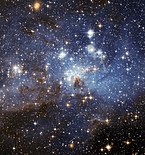
Back كتلة جينس Arabic Inestabilitat de Jeans Catalan Гравитацилле тĕрексĕрлĕх CV Jeans-Kriterium German Inestabilidad de Jeans Spanish ناپایداری جینز Persian Instabilité gravitationnelle French אי-יציבות ג'ינס HE Jeansova nestabilnost Croatian Instabilitas Jeans ID
| Star formation |
|---|
 |
| Object classes |
| Theoretical concepts |
This article includes a list of general references, but it lacks sufficient corresponding inline citations. (April 2022) |
The Jeans instability is a concept in astrophysics that describes an instability that leads to the gravitational collapse of a cloud of gas or dust.[1] It causes the collapse of interstellar gas clouds and subsequent star formation. It occurs when the internal gas pressure is not strong enough to prevent the gravitational collapse of a region filled with matter.[2] It is named after James Jeans.
For stability, the cloud must be in hydrostatic equilibrium, which in case of a spherical cloud translates to where is the enclosed mass, is the pressure, is the density of the gas (at radius ), is the gravitational constant, and is the radius. The equilibrium is stable if small perturbations are damped and unstable if they are amplified. In general, the cloud is unstable if it is either very massive at a given temperature or very cool at a given mass; under these circumstances, the gas pressure gradient cannot overcome gravitational force, and the cloud will collapse.[3] This is called Jeans collapse criterion.
The Jeans instability likely determines when star formation occurs in molecular clouds.
- ^ "Jeans instability". Oxford Reference. Retrieved 2024-01-05.
- ^ Bonnor, W. B. (1957). "1957MNRAS.117..104B Page 104". Monthly Notices of the Royal Astronomical Society. 117: 104. Bibcode:1957MNRAS.117..104B. doi:10.1093/mnras/117.1.104.
- ^ "The Jeans Collapse Criterion". csep10.phys.utk.edu. Retrieved 2024-01-05.





